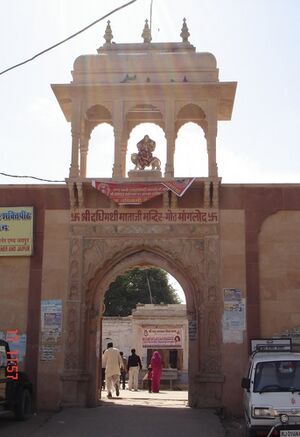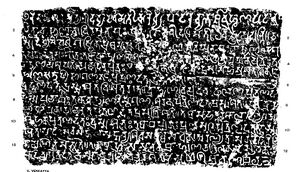Dadhimati Temple
| Author of this article is Laxman Burdak लक्ष्मण बुरड़क |

Dadhimati mata temple (दधिमती माता मंदिर) dedicated to goddess Dadhimati is located in Nagaur district of Rajasthan and is surrounded by villages Goth - Manglod. Dadhimati is said to be the sister of sage Dadhichi and born due to churning of sky. It is one of the oldest surviving temples in northern India. Archaeologically, it was built in the 4th century and is of the Gupta era, visited by Prof. Bhandarkar. Dadhimati is Avtar Of Goddess Lamxi. The temple has the oldest depictions of Devi Mahamatya even older than Mahalaxmi temple of Kolhapur, Maharashtra. It has a depiction of Valimiki Ramayana in interiors. It is A Historical Place of Rajasthan. It is One Shaktipitha out of 52 Shaktipithas.
Dadhimati Inscription of Dhruhalana of Gupta Year 289 (608 AD)
Reference - Epigraphia Indica Vol. XI, 1911-12, p.299-305
|
१. ओं नम:(॥) [स]रस्वत्यै [॥*] श्रीदध्या दधिमतीसंनिध्यपादानुध्याता[:*] श्रीध्रूह्लाणपादानु[पा]- २. लिता ब्राह्मणा अविघ्ननाग:प्रमुखा देवी दधिमाती विज्ञाययन्ति ॥ अ- ३. स्मिनं देव्या [नि]वेशे गोष्ठिकाप्रथमं आवो[ब्राह्म]ण अविघ्नना[ग]: ४. कपुत्र वच्छ्स:गोत्र: तथा ब्रह्मणमिश्र... कटक[पुत्र: मा]तुल्य पूफकपुत्रै: त[था] ५. ब्राह्मणयशपति: यक्षदिन्नपुत्र: ए[तै]मोष्ठिकै प्रतत्तः द्रम्मसहस्त्रं शताधिकं । व्रा ६.ह्मण्झ[ही]ह (।) गणभटपु[त्रे]ण दत्त द्रम्मशतं । .... ७. ब्राह्मणैर्दत्ते द्रम्मशतं विंशोतरं । तथा ब्राह्मणविष्णुदेव: ढूलणपुत्रेण द[त्त] ८. द्रम्मपंचाश: [।*] तथा ब्राह्मणनिम्बगण (।) शूरकपुत्रेण दत्त द्रम्मशतं [।*] [त]था ब्राह्म- ९. णधनियक (।) अचिन्तितपुत्रेण दत्त द्रम्मंत्रिशति तथा महत्तरबालादित्य (।) अ[वि] १०.गहकपुत्रेण दत: द्रम्मशतं: [॥*] तथा बप्पक(:)पूर्ण्णमुखपुत्रेण दत्त द्रम्म ११. शतं सार्द्ध: [॥*] सर्वमङगलमङ्गल्ये शिवे स[र्वा]र्थसाधके । अरण्ये त्रांबके गौरि(।) [ना]- १२. रायणि नमोस्तु ते ॥ तथा ब्राह्मसोमानक ब्रह्मण अचिलकं[दे][व*]सुवक: [नि]- १३. [स्व]ादित्यपुत्रैर्दत्त [द्र]म्मा ४ ॥ संवच्छरशेतेषु २०० ८० ९ श्रावण ब १० ३ |
| Dadhimati Inscription of Dhruhalana of G.E. 289 (608 AD)[1] |
This inscription is the oldest of all the inscriptions so far discovered in Marwar. It was found in a very ancient temple, which is dedicated to the goddess Dadhimati, commonly called Dadhyamataji, situated in a desert where the boundaries of two villages named Goth and Manglod meet. These villages are 24 miles north-east of Nagaur. The rims of the slab are raised one inch high on all sides, and it was discovered lying upside down in one of the corners of the hall of the temple of the goddess.
The inscription opens with obeisance to the goddess Sarasvati, Then follows a request to devi Dadhimati by the community (gosṭhikā) of Dadhyas, headed by Avighnanaga. These peope used to reside, it appears, in the same temple and were the worshippers of devi. A passing reference is also made here to one Sri-Dhrūhalāṇa, who appears to have been then the ruling prince, but who this chief was and where he ruled we are unable to ascertain.
Lines 3 to 10 contain the names and gotra-s of the donors with their father's names and the amount contributed by each, the details whereof are embodied here. The names of donors are:
- 1. Avighnanaga s/o Langaka Gotra Vachchha (clan:Avo आवो ),
- 2. ....Misra s/o Kataka,
- 3. Matulya s/o Puphaka,
- 4. Yashapati s/o Yakshadinna, (all of them contributed 1100 drammas)
- 5. Manjhahiha s/o Ganabhata (100 drammas),
- 6. .... .... ? (120 drammas),
- 7. Vishnudeva s/o Dhulana (50 drammas),
- 8. Nimbagana s/o Shuraka (100 drammas),
- 9. Dhaniyaka s/o Achintita (300 drammas),
- 10. Baladitya s/o Avigahaka (clan:Mahattara) (100 drammas),
- 11. Bappaka s/o Purnamukha (150 drammas),
- 12. Sonanaka s/o....,
- 13. Achilakade(va) s/o Nimbaditya,
- 14. Suvaka s/o Nimbaditya (all three 4 drammas).
Line-11 contains verse quoted from Markandeya Purana (सर्वमङगलमङ्गल्ये शिवे सर्वार्थसाधके । अरण्ये त्रांबके गौरि(।) नारायणि नमोस्तु ते). It means- O goddess Narayani, obeisance to thee, who art the source of all blessings, doer of good, accomplisher of desired objects, giver of shelter, endowed with three eyes and Gauri, i.e. the spouse of the god Mahadeva. Then follow (L.12) the names of the Brahmanas numbered 12-14 above. The last line (L.13) gives the date which is 13th of the dark half of shravana of year Gupta Era 289 (= V.S.665 or 608 AD). The formation of characters resembles that of Mandsaur pillar inscription of Yashodharman. It may be inferred that the temple of Dadhimata was insitu when contribution was raised by Dadhya Brahmanas headed by Avighnanaga.

In the beginning of this inscription there is mention of Dadhya Brahmanas. They are now-a-days known as Dahiya or Dahima Brahmans and one of the chha-nyāti (six castes who inter-dine but do not inter-marry, viz. Dahima, Parikha, Ganḍa, Gujar-ganḍa, Sarasvata, and Ṥikhawāla (same as Khandelawala) of the Pancha-ganda section. There is no doubt that Dadhyas of our inscription are Dahiyas or Dahima Brahmans because of following reasons:
- 1. they consider this goddess Dadhimati as their Kuladevi,
- 2. Majority of their population is in surrounding villages scattered in 10 to 20 kos area,
- 3. Most of the modern names of Khampas (clans) of this community are after the names of villages situated around the temple for example:
- Gothiya (गोठिया), Gothecha (गोठेचा) after village Goth (गोठ),
- Maangloda (मांगलोदा), Manglodya (मांगलोद्या) after village Manglod (मांगलोद),
- Asopa (आसोपा) after village Asop (आसोप),
- Inanya (इनाण्या) after village Inana (इनाणा),
- Khatre (खटड़े), Khatoda (खाटोड़ा), Khatkad (खटकड़) after village Khatu (खाटू),
- Bora (बोरा) Borada (बोराड़ा), Borwar (बोरवार) after Borawar (बोरावड़),
- Didwana (डिडवाना), Deedwal (डीडवाल), Didawanya (डीडवाण्या) after Didwana (डीडवाणा) etc.
Dahimas assert that they have descended from Dadhichi Rishi and style them as Dadhichas, while in this inscription they are termed as Dadhyas (दध्या) after the name of Dadhimata. Epithet Mishra used in S.No. 2 above was common in those days and is still used by Dahimas.
In the third line there is a clan name Avo (आवो) but there is no clan among Dahimas by this name. It therefore appears that it is perhaps a contracted form of the word Avoti (आवोटी) just as the word brahnana is written in the abbreviated form brahra in line 12. It is also possible that the letter ti of the word Avoti has been carelessly omitted. The word Avoti or Aboti means a worshipper ; and hence it may be inferred that the Dadhyas were worshippers of the goddess Dadhimati in those days. The office of worshipping this goddess is now held by the Sevagas (or Bhojakas). It is just possible that the Dadhya-Brahmanas, as they took up some other profession, later on employed a Sevaga for this purpose, whose descendants are up to this day doing the same work. This supposition is farther strengthened by the fact that the Dahima-Brahmanas of the village Rol Nagaur, 10 miles from this temple, even now personally perform the worship of the deity and offer oblations in her honour in the months of Chaitra and Ashvina when fairs are held in and around the temple. In these fairs the inhabitants of the adjoining villages meet together to worship the goddess and offer their cattle for sale.
The most noteworthy information furnished by this inscription is the light it throws on the date of the Markandeya-Purana. In line 11 of our inscription is quoted the 9th verse of the 91st chapter of that Purana or the 10th chapter of the Devi-Mahatmya, as the latter begins from the 81st chapter and ends with the 93rd. From this quotation we can conclusively and convincingly assert that the Devi-Mahatmya was composed before V. S. 665, i.e. before the 7th century A.D. It would, therefore, be futile if any one were to assign a date, later than the 7th century, to the Devi-Mahatmya or the Markandeya-Purana. The section Devi-Mahatmya is regarded by some scholars as an interpolation, but what can with certainty be contended is that the Devi-Mahatmya is not a production later than the 7th century or thereafter. Rev. K. M. Banerjea writes in the introduction to his edition of the as follows :
- " We cannot help noticing in this place the dignity imparted to the work under review. It is classed in the same category with the Vedas, and described as an immediate product from Brahma's mouth. Although a Purana, it is not attributed to Vyasa, whom other Shastras consider as the author of all works bearing that title. The Markandeya Purana, however, does not acknowledge him, as its composer, editor or compiler. It claims equal honour in this respect with the Vedas themselves."
And he says in the beginning of his preface that " the section called Devi-Mahatmya was probably an, interpolation." A reference to chapter 94, verse 1, would show that when recapitulating the past, the speaker (i.e. Markandeya-Purana) says that he has caused him (the addressee, i,e, Kraushtuki-Rishi) to hear the Devi-Mahatmya. This internal evidence alone is sufficient to prove that the Devi-Mahatmya, is not an interpolation but forms a part and parcel of the Markandeya-Purana. Besides, if the Devi-Mahatmya were to be removed from it, total number of verses attributed to this Purana in the commencement would fall short by the number contained in the Mahatmya.
Our inscription does not give the names of clans wherewith the Dadhya Brahmana were then known; and the two names Avo and Mahattara, which may be presumed to be clan names are not identical with the modern ones. It is therefore evident that the present Khampas such as Gothecha, etc., must have been introduced only after V. S. 665. There is one gotra mentioned in the inscription, Vachchha (Vatsa) which is even now found among the Dahima-Brahmanas. Had their present clans been well known, they would certainly have been mentioned as the epithet Misra has been in L.4 The record does not contain the name of the person who composed it, nor of the man wno engraved it.
Notes by Wiki editor -
- Dadhyas (दध्या) - Dadhya seems to be Sanscritization of Dahiya. Dahi of Prakrat is Dadhi in Sanscrit. Dadhyas thus represents Dahiyas, found in Rajasthan in Brahmanas, Jats and Rajputs. The Author of the Inscription had no Idea about Dahiya Jats so he concentrated mainly on Dahiya Brahmanas. It is important because many Jat clans in this part of Rajasthan condider originated from Rishi Dadhichi.
- Chilaka - The Name of donor at S. No. 13. Achilakade(va) s/o Nimbaditya, seems connected with Chilka Jat clan.
- Avighnanaga - The community (gosṭhikā) of Dadhyas is headed by Avighnanaga. The Naga ending names indicates their Nagavanshi linkages. Were they Nagavanshi Brahmans ?
- Sri-Dhrūhlāṇa (श्री ध्रूह्लाण) - A passing reference is made here to one Sri-Dhruhlana, who appears to have been then the ruling prince, but who this chief was and where he ruled is not clear. He must be a Nagavanshi King?
- Matulya (मातुल्य) - Matulya s/o Puphaka mentioned at S.No. 3 may represent Matwa Jat clan ?
- Vachchhasa (वच्छ्स) - It is mentioned as Gotra of Avighnanaga. Its sanskrit version is Vatsa (वत्स) which is also the Gotra of Chauhans. This also indicates Nagavanshi linkages of Chauhans.
Photo gallery of Temple
-
Dadhimati Mata Statue
-
Dadhimati Mata Temple Statues
-
Dadhimati Mata Temple Statues
-
Dadhimati Mata Temple Statues
-
Dadhimati Mata Temple Statues
-
Dadhimati Mata Temple Statues
-
Dadhimati Mata Temple at Manglod
-
Kund at Dadhimati Mata Temple
-
Kund at Dadhimati Mata Temple
References
Back to Jat Monuments/Jat Deities










